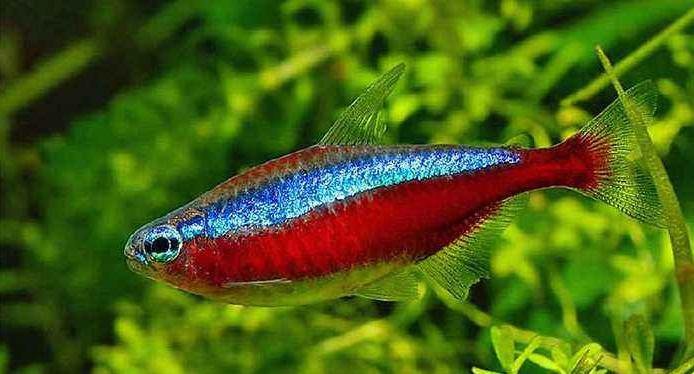Most of the light fish give us the feeling of being small, lively and attractive. Even some groups are relatively large, and the feeling of being very large in the case of a very large fish tank is very spectacular. Lamp fish are often raised in grass tanks, and basically every grass tank is indispensable to the figure of lamp fish. Agile, they often shuttle through the gaps in the leaves of aquatic grass, and often go out in groups to forage for food and gain a sense of security. Aquarists who love small fish must not miss the lamp fish. There are many kinds of lamp fish, where to start? In this issue, we will talk about where to start choosing the lamp fish. The following will introduce and recommend to you three kinds of lamp fish with relatively high appearance.
<h1 class= "pgc-h-center-line" > Pauline lamp</h1>
Some aquarists see this and ask, why is it not a traffic light but a Pauline lamp? I have asked many aquarists, including novice Xiaobai and straw tank masters, and most of them have always thought that the Po Lin Lantern gives them a better feeding experience. It is easier to die than traffic lights, and it is more pretentious. And the color is not better than the Pauline lamp. Native to the Amazon rivers, Pauline lamps prefer acidic water, and are usually driven in large groups in the wild, which is perfect for raising them in acidic water like grass tanks. The red stripes at the bottom of the Pauline lamp run from the head to the tail, and the body color of the traffic light fish is more vivid. Traffic lights are usually mostly blue and less red, which cannot give people a distinct sense of direct vision.

Pauline Lantern's personality is relatively small, and he likes to hide in Tibet. The grass tank is very suitable for raising them. The water weeds alone were enough for them to hide. Pauline lamp is more timid, but does not like to jump the cylinder. If the number of Pauline lanterns reaches a certain amount, then they will be bold and there will be a spectacular scene of group swimming. Don't look at the price of Pauline lamps is more expensive than traffic lights, think they are easy to die, difficult to raise, mainly in terms of appearance, in fact, they are not arrogant at all, even if they are small seedlings are also very good service. As long as the water temperature is not too low, keep acidic, do not let the harmful substance content exceed the standard, to meet these three basic conditions Pauline lamp is also very good to raise.
< h1 class= "pgc-h-center-line" > red nose scissors</h1>
Red-nosed scissors are also a fish that prefers acidic water and is a tropical fish. Listen to its name, you may be able to guess why it is called red nose see scissors. The part of the mouth above the front of the red-nosed scissors is red, and its tail is similar to scissors, which is completely comparable to the tail of a swallow. Red nose scissors have a very docile personality and are also very good to raise. Suitable for polyculture. The small fish itself is not aggressive in size, and the red-nosed scissors personality is still so docile, and polyculture is basically a matter of minutes. Polyculture with other lamp fish is no problem. Red nose scissors are also a fish with a very strong swimming ability, and aquarists with large fish tanks must consider it carefully!
The basic conditions that need to be met for red nose scissors are the same as Pauline lamps. Can be polycultured with each other. But if you mix the two together, the group travel phenomenon may be different. They would split into two groups, a group of red-nosed scissors, a group of Pauline lamps, would have independence, would not mix together. Polyculture needs to pay attention not to let the larger size of them bite or bite them to death.
<h1 class="pgc-h-center-line" > white cloud gold wire</h1>
The last one is our domestic products. Baiyun gold silk originated in southern China, is a kind of cold-water fish, five degrees low temperature is no problem! Baiyun Jinsi prefers weak acidic water quality, and now there are very few wild individuals, which have been listed as national second-level key protected animals. However, artificial farming can be bought and sold, and it is not illegal. White cloud gold wire not only often appears in the grass tank, but it is also a regular visitor in the original tank. Although the water quality they are most suitable for is weakly acidic water quality. But this is only the textbook standard feeding method, and it can also adapt to the acidic water quality of the grass tank.
The characteristics of white cloud gold wire are particularly hardy and resistant to coarse breeding, without deliberate care. I once raised white cloud gold wire in a tank without filtering, with lights and bottom sand. As the algae grows, a small ecosystem is formed. I hardly ever fed food, and Baiyun Jinsi grew from a little fry to an adult by eating some algae and occasionally eating some feed. In the end, the original tank lover aquarists took my white cloud gold wire, but it was still taken away.
The above three kinds of lamp fish are relatively cheap, and I think it is still very good to raise. If your fish tank environment is not particularly harsh, then raising these three kinds of fish is completely good.
If you also like to raise ornamental fish, you may wish to start pointing out a point of attention, all you need to know about fish farming is here.